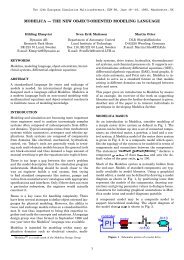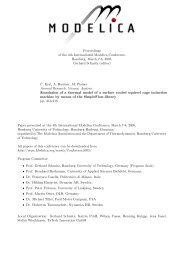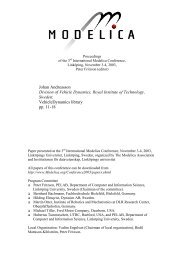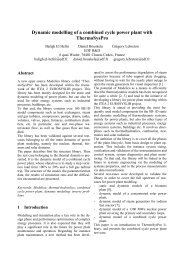SoundDuctFlow: A Modelica Library for Modeling Acoustics and ...
SoundDuctFlow: A Modelica Library for Modeling Acoustics and ...
SoundDuctFlow: A Modelica Library for Modeling Acoustics and ...
Create successful ePaper yourself
Turn your PDF publications into a flip-book with our unique Google optimized e-Paper software.
Proceedings 7th <strong>Modelica</strong> Conference, Como, Italy, Sep. 20-22, 2009<br />
<strong>SoundDuctFlow</strong>: A <strong>Modelica</strong> <strong>Library</strong> <strong>for</strong> <strong>Modeling</strong><br />
<strong>Acoustics</strong> <strong>and</strong> Flow in Duct Networks<br />
Abstract<br />
Helmut Kühnelt Thomas Bäuml Anton Haumer<br />
Austrian Institute of Technology, Mobility Department<br />
Giefinggasse 2, A-1210 Vienna, Austria<br />
{helmut.kuehnelt,thomas.baeuml,anton.haumer}@ait.ac.at<br />
<strong>SoundDuctFlow</strong>, a <strong>Modelica</strong> library <strong>for</strong> the joint<br />
calculation of acoustic <strong>and</strong> flow quantities in<br />
HVAC (Heating, Ventilation <strong>and</strong> Air Conditioning)<br />
ducts is presented. <strong>Modeling</strong> the sound propagation<br />
in ducts by one dimensional acoustic twoport<br />
methods is a well-established technique <strong>for</strong><br />
the acoustic characterization of large HVAC duct<br />
networks. Two different approaches of acoustic<br />
modeling will be considered in the framework:<br />
When resonant phenomena are insignificant, it is<br />
often sufficient to apply b<strong>and</strong>-averaged models to<br />
predict the sound power level <strong>and</strong> the transmission<br />
loss within the individual components of the duct<br />
network. For the low frequency range where linear<br />
plane wave propagation is valid, acoustic two <strong>and</strong><br />
multi-port models based on a transmission matrix<br />
<strong>for</strong>mulation of the sound pressure can be applied<br />
<strong>for</strong> high frequency resolution <strong>and</strong> phase accurate<br />
calculations. For the prediction of the mean air<br />
flow in the duct network pressure loss models<br />
are applied. The coupling of acoustic <strong>and</strong> flow<br />
elements permits the simulation of flow acoustic<br />
phenomena.<br />
For setting up large networks a smooth work<br />
flow is vital <strong>for</strong> the user: The simulation is<br />
easily set up using the GUI provided by Dymola.<br />
External parameterisation ensures persistent data<br />
management. The resulting system of equations<br />
is automatically pre-processed <strong>and</strong> solved by Dymola.<br />
In this paper an overview of this new library is<br />
given together with exemplary applications.<br />
Keywords: acoustics; flow; ducts; flow noise;<br />
HVAC; modeling; simulation; <strong>Modelica</strong> library<br />
1 Introduction<br />
The joint calculation of sound level, air flow rate<br />
<strong>and</strong> pressure loss in large HVAC duct networks as<br />
well as the prediction of the noise level in the passenger<br />
compartment gains more <strong>and</strong> more in importance<br />
in the early phase of design. The unified<br />
<strong>Modelica</strong> framework <strong>for</strong> one-dimensional acoustic<br />
<strong>and</strong> flow simulation introduced here serves as a<br />
tool <strong>for</strong> concept modeling. Used by the design<br />
engineer in an early design phase, it has to meet<br />
several requirements: The prediction method has<br />
to be fast <strong>and</strong> computational efficient. All kinds<br />
of available data should be used, from analytic<br />
<strong>and</strong> (semi)empiric models to data obtained from<br />
measurements <strong>and</strong> three-dimensional acoustic <strong>and</strong><br />
fluid dynamics computer simulations to characteristic<br />
diagrams <strong>and</strong> sparse point data provided<br />
by component manufacturers. It also should be<br />
extendable to add physical phenomena like heat<br />
transfer or transport of humid air <strong>and</strong> complex<br />
flow-acoustic interactions. Finally the framework<br />
should be open <strong>for</strong> integration into a complete<br />
system simulation.<br />
2 <strong>Modeling</strong> acoustics in duct<br />
networks<br />
In modeling acoustics of duct networks usually<br />
following assumptions are made: Only the steady<br />
state of the system has to be regarded. The<br />
dimensionality of the systems often can be reduced<br />
from 3-D to 1-D. The acoustic properties of each<br />
component can be characterized by an acoustical<br />
two-port (or a multi-port in the case of a branching),<br />
a grey box whose transfer behavior can be<br />
calculated by means of 1-D to 3-D methods, like finite<br />
(FEM) or boundary element methods (BEM),<br />
© The <strong>Modelica</strong> Association, 2009 519 DOI: 10.3384/ecp09430115
Proceedings 7th <strong>Modelica</strong> Conference, Como, Italy, Sep. 20-22, 2009<br />
independently from each other. Two st<strong>and</strong>ard<br />
one-dimensional approaches are available:<br />
First, the sound power-based description has<br />
been widely used <strong>and</strong> <strong>for</strong>ms the basis of the most<br />
st<strong>and</strong>ards <strong>and</strong> guidelines <strong>for</strong> the analysis of sound<br />
in ducts, e.g. see ASHRAE [1, 2] or VDI [3].<br />
It can be applied <strong>for</strong> frequencies well above the<br />
plane wave cut-off. The sound power level within<br />
a duct network can be determined by summation<br />
of the losses <strong>and</strong> gains in sound power level at the<br />
connecting interfaces of the components from the<br />
fan towards the terminal sections of the network.<br />
All contributions resulting from wave reflections<br />
are neglected in this approach. This makes the<br />
prediction procedure very simple, but reduces the<br />
reliability considerably.<br />
Second, the plane wave based description of<br />
ducts, mufflers <strong>and</strong> networks [4, 5, 6] covers the<br />
low frequency range. A variety of analytical<br />
plane wave two-port models is available in the<br />
literature. The acoustical transmission matrix of<br />
non-st<strong>and</strong>ard components can be determined by<br />
3-D FEM/BEM or unsteady CFD simulations in<br />
case of non-zero mean flow. In HVAC duct networks<br />
with their large lateral dimensions, however,<br />
the frequency range of plane wave propagation is<br />
rather limited. Nevertheless, accurate sound prediction<br />
at lower frequencies below a few hundred<br />
Hz is quite important, since absorbing liners are<br />
ineffective at those frequencies. In Table 1 the<br />
plane wave cutoff frequency, fc, is given <strong>for</strong> some<br />
exemplary circular ducts.<br />
Table 1: Plane wave cutoff frequencies <strong>for</strong> circular<br />
ducts.<br />
diameter fc typical usage<br />
10 mm 20 kHz brass wind instrument<br />
50 mm 4 kHz car exhaust pipe<br />
300 mm 670 Hz HVAC ducts<br />
2.1 Sound power-based description<br />
The sound power-based description of sound<br />
transmission in ducts is valid <strong>for</strong> frequencies well<br />
above the plane wave cut-off. Wave reflections<br />
are neglected. The transmission loss of a duct<br />
element is considered. The variable of state then<br />
is the sound power level LW :<br />
LW = 10log 10<br />
� Pac<br />
P0<br />
�<br />
dB (1)<br />
© The <strong>Modelica</strong> Association, 2009 520<br />
with a reference sound power level P0 = 10 −12<br />
Watt. Typically LW is specified <strong>for</strong> octave or 1/3octave<br />
frequency b<strong>and</strong>s. The summation of levels<br />
Li obeys the following rule:<br />
n�<br />
Lsum = 10log10 10<br />
i=1<br />
Li/10<br />
(2)<br />
The acoustic elements based on the sound power<br />
description are extended from one, two or multiports.<br />
Each port is represented by a signalbased<br />
connector holding two arrays of incoming<br />
<strong>and</strong> outgoing LW in N frequency b<strong>and</strong>s. Since<br />
there are no reflections considered, in passive<br />
elements like silencers, each incoming LW signal<br />
is mapped onto the outgoing LW independently<br />
of its counterpart:<br />
LW i out<br />
A = LW i in B − ∆LW iB→A<br />
LW i out<br />
B = LW i in A − ∆LW iA→B<br />
(3)<br />
with ∆LW i the reduction of the sound power level<br />
at the ith b<strong>and</strong>. This allows bidirectional usage of<br />
the components.<br />
In-duct sources, like fans or bends contributing<br />
regenerated flow-noise, add their <strong>for</strong>ward <strong>and</strong><br />
backward contribution to the total sound pressure<br />
level according to eq. (2)<br />
Figure 1 gives some examples of acoustic components<br />
already included in <strong>SoundDuctFlow</strong>, like<br />
different types of pipes, bends, silencers, fans.<br />
2.2 Plane wave description<br />
In the wave based description the steady state,<br />
frequency dependent plane wave solution of the<br />
wave equation is regarded. This approach is valid<br />
only <strong>for</strong> the low frequency region below the plane<br />
wave cut off. Although this region is rather<br />
limited because of the large lateral dimensions<br />
usually found in HVAC duct networks, an accurate<br />
calculation is nevertheless important, since<br />
absorbing materials are rather ineffective at those<br />
frequencies. Two physically equivalent methods<br />
can be applied to characterize the individual duct<br />
element.<br />
In the scattering matrix method the sound pressure<br />
p is decomposed into <strong>for</strong>wards <strong>and</strong> backwards<br />
traveling plane waves:<br />
p(x,t) = ˆp(x)exp iωt = p + exp i(ωt−kx) +p − exp i(ωt+kx)<br />
(4)
Proceedings 7th <strong>Modelica</strong> Conference, Como, Italy, Sep. 20-22, 2009<br />
where k = ω/c0, p + <strong>and</strong> p − are the amplitudes<br />
of <strong>for</strong>wards <strong>and</strong> backwards traveling waves. The<br />
acoustic particle velocity then is:<br />
ˆv = 1 �<br />
p<br />
ρ0c0<br />
+ exp −ikx −p − exp ikx�<br />
. (5)<br />
A four pole scattering matrix S maps the <strong>for</strong>ward<br />
<strong>and</strong> backward propagating sound pressures<br />
of one port onto the second port:<br />
�<br />
p + 1<br />
p − � �<br />
=<br />
1<br />
S11 S12<br />
S21 S22<br />
Figure 1: Examples of acoustic elements.<br />
��<br />
p + 2<br />
p − �<br />
2<br />
(6)<br />
This <strong>for</strong>mulation is preferred in connection with<br />
the experimental determination of the acoustic<br />
reflection coefficient R = p − /p + at the interfaces<br />
of duct elements.<br />
The transmission matrix method describes the<br />
relation between acoustic pressure, p, <strong>and</strong> acoustic<br />
volume flow, q, in <strong>for</strong>ward <strong>and</strong> backward sections<br />
of the single element by the matrix T :<br />
� � � �� �<br />
p1 T11 T12 p2<br />
=<br />
q1 T21 T22 q2<br />
(7)<br />
This <strong>for</strong>mulation is preferred <strong>for</strong> modeling in<br />
<strong>Modelica</strong> since the potential variable p <strong>and</strong> the<br />
flow variable q directly can be used to constitute<br />
the physical connector.<br />
A collection of plane wave models will be included<br />
into the <strong>SoundDuctFlow</strong> library.<br />
2.3 <strong>Modeling</strong> of junctions<br />
In the sound power-based description, at junctions<br />
the incident sound power is distributed over the<br />
total of all outgoing duct sections. By definition<br />
there are no reflections. The proportion of the<br />
© The <strong>Modelica</strong> Association, 2009 521<br />
sound power transmitted from section i to section<br />
j, Wi→j, then is<br />
Sj<br />
Wi→j = Wi<br />
Stot − Si<br />
(8)<br />
where Wi is the sound power incident at the duct<br />
section i, Si, Sj <strong>and</strong> Stot are the incident, outgoing<br />
<strong>and</strong> total cross-sectional areas.<br />
In the plane wave model, the reflection of<br />
waves at a multiple junction is considered. As<br />
an example a T-shaped junction between three<br />
pipes of cross-sectional surfaces A1, A2 <strong>and</strong> A3 is<br />
examined here. From the equation of Bernoulli we<br />
find that the acoustic pressures p1 <strong>and</strong> p2 in the<br />
duct just be<strong>for</strong>e <strong>and</strong> after the side-branch have to<br />
be the same as the pressure p3 at the mouth of the<br />
side-branch:<br />
p1 = p2 = p3<br />
(9)<br />
The conservation of mass yields that the sum of<br />
the acoustic volume flows at the junction is zero:<br />
q1 + q2 + q3 = 0 (10)<br />
3 <strong>Modeling</strong> flow <strong>and</strong> pressure<br />
loss in duct networks<br />
The 1-d modeling of air flow in HVAC ducts <strong>and</strong><br />
other components is based on several approximations:<br />
The air flow in HVAC ducts with its<br />
low Mach number is regarded as incompressible,<br />
steady state <strong>and</strong> fully stabilized. In most cases it<br />
is also turbulent. The state variables <strong>for</strong> fluid flow<br />
are the static pressure as the potential variable<br />
<strong>and</strong> the mass flow rate as the flow variable. The<br />
pressure loss coefficient K = ∆P<br />
ρU 2 relates the<br />
/2<br />
pressure difference ∆P between the two ports<br />
of an flow duct element to the kinetic energy<br />
density of the flow. It depends on the Reynolds
Proceedings 7th <strong>Modelica</strong> Conference, Como, Italy, Sep. 20-22, 2009<br />
number, on the relative roughness <strong>and</strong> on the<br />
cross-sectional shape of the duct.<br />
Analytic models, like the Colebrook-White<br />
equation, as well as measurement data, given as<br />
characteristic diagram or interpolated <strong>for</strong>mula<br />
[7, 8, 9] or tabulated manufacturer data serves<br />
as input <strong>for</strong> the various flow models. Effects<br />
by turbulence, adverse velocity gradients, crosssectional<br />
shape, surface roughness, curvature,<br />
interaction between elements in not fully<br />
developed flow regions result in corrective terms.<br />
Within the <strong>Modelica</strong> library flow elements <strong>for</strong><br />
st<strong>and</strong>ard duct components are available (Fig. 2).<br />
4 Complex duct components<br />
Complex compound flow-acoustic duct components<br />
(see Fig. 3) can be assembled from simple<br />
elements representing either the acoustic or the<br />
flow part of a duct element using a special connector<br />
that combines the acoustic <strong>and</strong> the flow<br />
connector. This allows the modeling of nonst<strong>and</strong>ard<br />
components.<br />
Figure 3: Complex compound flow-acoustic duct<br />
component utilizing a combined flow-acoustic<br />
connector.<br />
Figure 2: Examples of flow elements.<br />
© The <strong>Modelica</strong> Association, 2009 522<br />
5 Flow-acoustic interaction<br />
Flow-acoustic coupling can also be modeled on<br />
this basis. Inside duct elements, like bends or<br />
orifices, the high Reynolds number flow triggers<br />
flow noise. In most cases the back-reaction of<br />
the sound field on the flow is negligibly weak.<br />
This effect can be modeled by extracting the<br />
state of the fluid flow <strong>and</strong> feeding it into the<br />
acoustic element. There the additional flow noise<br />
is calculated by (semi)empirical models, as given<br />
in [3, 10] <strong>for</strong> instance. An example of a complex<br />
compound pipe component with flow noise is given<br />
in Fig. 4.<br />
Figure 4: Compound flow-acoustic duct component<br />
in which the mean flow velocity generates<br />
flow noise at the bend.<br />
6 Work flow <strong>and</strong> practical issues<br />
When dealing with large models, the parameterisation<br />
of each component in the Dymola GUI is<br />
error-prone <strong>and</strong> not very convenient <strong>for</strong> the user,
Proceedings 7th <strong>Modelica</strong> Conference, Como, Italy, Sep. 20-22, 2009<br />
Figure 5: Acoustic representation of of a ventilation unit.<br />
(a) (b)<br />
Figure 6: A-weighted LW in third octave b<strong>and</strong>s at the suction side (a) <strong>and</strong> pressure side (b) components<br />
of a ventilation unit.<br />
especially when the parameters are varied repeatedly<br />
within the design process. There<strong>for</strong>e we use<br />
an external parameterisation procedure to ensure<br />
consistent data h<strong>and</strong>ling <strong>and</strong> a smooth work flow:<br />
After setting up the model in the Dymola GUI, all<br />
model parameters <strong>and</strong> connections are extracted<br />
into an XML structure. This XML structure then<br />
is filled in with the parameters’ numerical values<br />
<strong>and</strong> read in at the run time of the simulation. All<br />
results are also written to an XML file <strong>for</strong> external<br />
postprocessing procedures like report generation.<br />
7 Examples<br />
As a first example, the acoustic representation of<br />
a ventilation unit is presented in Fig. 5. Here it<br />
it is not connected to the duct network but in<br />
a configuration <strong>for</strong> measuring the radiated sound<br />
power from its exits. There<strong>for</strong>e the nozzle reflections<br />
at the intake <strong>and</strong> exhaust pipe terminations<br />
have to be included. The predicted A-weighted<br />
LW at each element is shown in Fig. 6. Prediction<br />
© The <strong>Modelica</strong> Association, 2009 523<br />
<strong>and</strong> measurement of the A-weighted LW at the<br />
exits (Table 2) agree quite well.<br />
Table 2: Measured <strong>and</strong> predicted A-weighted<br />
sound power level of a ventilation unit.<br />
Position<br />
Sound power level LwA<br />
Measurement Prediction<br />
Pressure Side 52 dB(A) 50.4 dB(A)<br />
Suction Side 54 dB(A) 51.9 dB(A)<br />
The ventilation unit is then installed in a small<br />
duct network (Fig. 7). The predicted third b<strong>and</strong><br />
SPL at each element is shown in Fig. 8.<br />
8 Conclusions <strong>and</strong> perspectives<br />
The concepts of sound propagation in HVAC<br />
systems together with modeling of the air flow<br />
are realized in the new <strong>Modelica</strong> library Sound-<br />
DuctFlow, providing a joint prediction of the noise<br />
level <strong>and</strong> the pressure loss in the duct network.<br />
The concept of acoustical connectors based either
Proceedings 7th <strong>Modelica</strong> Conference, Como, Italy, Sep. 20-22, 2009<br />
Figure 7: Acoustic representation of a ventilation duct network.<br />
(a) (b)<br />
Figure 8: A-weighted LW at each element of a ventilation duct network along two paths from the fan<br />
to a listener, (a) at the suction side <strong>and</strong> (b) the pressure side.<br />
on a sound power level description or a plane<br />
wave description was discussed. The effects of<br />
the geometric conditions on the mean air flow<br />
is modeled by 1D pressure loss models. The<br />
triggering of noise by flow effects is also modeled.<br />
The modeling of the emitted noise level of a<br />
ventilation unit agrees quite well with acoustical<br />
measurements.<br />
<strong>SoundDuctFlow</strong> will be extended to incorporate<br />
also heat transfer, transport of humid air <strong>and</strong><br />
complex flow-acoustic interactions. For the last<br />
point, however, there will be the need <strong>for</strong> new<br />
models deduced from complex 3D computational<br />
aeroacoustic simulations.<br />
© The <strong>Modelica</strong> Association, 2009 524<br />
9 Acknowledgments<br />
We are very grateful to Gerhard Karlowatz,<br />
Liebherr-Transportation Systems, Austria,<br />
<strong>for</strong> providing real life network examples <strong>and</strong><br />
measurement results.
Proceedings 7th <strong>Modelica</strong> Conference, Como, Italy, Sep. 20-22, 2009<br />
References<br />
[1] Reynolds, D. D. <strong>and</strong> Bledsoe, J. M.,<br />
Algorithms <strong>for</strong> HVAC <strong>Acoustics</strong>, ASHRAE<br />
Inc., Atlanta, 1991.<br />
[2] ASHRAE, Sound <strong>and</strong> Vibration Control,<br />
2007 ASHRAE H<strong>and</strong>book – HVAC Applications,<br />
ASHRAE Inc., Atlanta, 2007 (Chapter<br />
47).<br />
[3] VDI, Association of German Engineers, VDI<br />
Guideline 2081, VDI, Düsseldorf, 2001.<br />
[4] Munjal, M. L., <strong>Acoustics</strong> of Ducts <strong>and</strong><br />
Mufflers, Wiley, New York, 1987.<br />
[5] Boden, H. <strong>and</strong> Abom, M., Modelling of Fluid<br />
Machines as Sources of Sound in Duct <strong>and</strong><br />
Pipe Systems, Acta Acustica, 3 (1995), 545-<br />
560.<br />
[6] Boden, H. <strong>and</strong> Glav, R., Exhaust <strong>and</strong> Intake<br />
Noise <strong>and</strong> Acoustical Design of Mufflers<br />
<strong>and</strong> Silenecers, in H<strong>and</strong>book of Noise <strong>and</strong><br />
Vibration Control, ed. by Crocker, M. J.,<br />
John Wiley & Sons, 2007.<br />
[7] Miller, D. S., Internal Flow Systems, BHR<br />
Group Limited, Cranfield, UK, 1996 (2nd<br />
ed).<br />
[8] Idelchik, I.E., H<strong>and</strong>book of Hydraulic Resistance,<br />
Begell House, 1996 (3rd ed).<br />
[9] Recknagel, Sprenger, Schramek, Taschenbuch<br />
für Heizung und Klimatechnik. R. Oldenbourg<br />
Verlag, München Wien, 1999 (69th ed).<br />
[10] Nelson, P. A. <strong>and</strong> Morfey, C. L., Aerodynamic<br />
sound production in low speed<br />
flow ducts, Journal of Sound <strong>and</strong> Vibration,<br />
79(1981), 263–289.<br />
© The <strong>Modelica</strong> Association, 2009 525

















